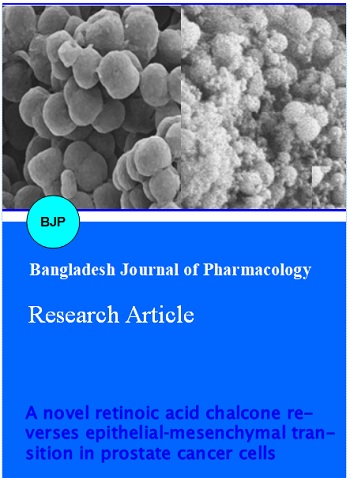A novel retinoic acid chalcone reverses epithelial-mesenchymal transition in prostate cancer cells
DOI:
https://doi.org/10.3329/bjp.v10i2.22602Keywords:
Prostate cancer, mesenchymal marker, invasiveness, transcription factor, cell motilityAbstract
The present study was performed to investigate the effect of retinoic acid fluoro chalcone (RAFC) on lipopolysaccharide (LPS) induced epithelial-mesenchymal transition (EMT) in PC3 and CWR22rv1 prostate cell lines. Lipo-polysaccharide (LPS) was used to induce epithelial-mesenchymal transition in prostate carcinoma cell lines. The results revealed that treatment of PC3 and CWR22rv1 cells with LPS resulted in significant changes in the morphological features of the EMT. The mesenchymal marker, vimentin expression was significantly increased whereas the expression level of E?cadherin was markedly decreased after the treatment. We also observed increased cell motility and higher level of transcription factor glioma?associated oncogene homolog 1 (Gli1) expression on LPS treatment. Treatment of prostate cells with RAFC reversed the morphological changes induced by LPS in prostate cells. RAFC also reduced the expression of EMT markers induced by LPS and suppressed the Gli1 expression. The resultant effect of these changes was the suppression of motility and invasiveness of the prostrate cells. Thus, RAFC exhibited anti?invasive effect on prostrate cells by inhibition of the EMT process via Hedgehog signaling pathway.
Downloads
2114
824 Read
599

Published
How to Cite
Issue
Section
License
Authors who publish with this journal agree to the following terms:
- Authors retain copyright and grant the journal right of first publication with the work simultaneously licensed under a Creative Commons Attribution License that allows others to share the work with an acknowledgement of the work's authorship and initial publication in this journal.
- Authors are able to enter into separate, additional contractual arrangements for the non-exclusive distribution of the journal's published version of the work (e.g., post it to an institutional repository or publish it in a book), with an acknowledgement of its initial publication in this journal.
- Authors are permitted and encouraged to post their work online (e.g., in institutional repositories or on their website) prior to and during the submission process, as it can lead to productive exchanges, as well as earlier and greater citation of published work (See The Effect of Open Access).
